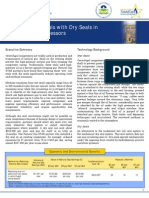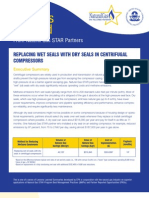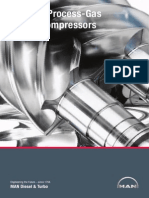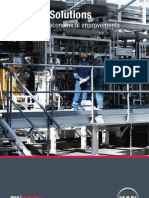Carbon Seals
Carbon Seals
Uploaded by
Sh.nasirpurCopyright:
Available Formats
Carbon Seals
Carbon Seals
Uploaded by
Sh.nasirpurOriginal Description:
Copyright
Available Formats
Share this document
Did you find this document useful?
Is this content inappropriate?
Copyright:
Available Formats
Carbon Seals
Carbon Seals
Uploaded by
Sh.nasirpurCopyright:
Available Formats
> Read full chapter
Novel Machinery
Natalie R. Smith, ... Timothy C. Allison, in Compression Machinery for Oil and Gas,
2019
Hermetically Sealed and Oil-Free Compression
Hermetically sealed compressors have emerged into more markets over the past
several years. Historically, hermetically sealed compression systems have been op-
erating in the so-called clean gas applications for over three decades. More recently,
further applications seek to take full advantage of the hermetically sealed design. In
the offshore oil and gas business sector, for example, the very compact footprint of
hermetically sealed compressor skids is advantageous given the space and weight
restrictions on production platforms. These electric motor-driven compressors are
packaged such that the entire rotating shaft from driver side to driven equipment,
including motor, coupling, all impellers, diaphragms, and bearings are enclosed in-
side a pressure containment vessel. By doing this, all rotor-to-ambient-air interfaces
are eliminated and the need for seals, for example, dry gas seals (DGSs), oils seals,
or carbon ring seals, between the process gas and the environment is removed.
Process gas leakage is completely eliminated which is attractive from a performance
and an environmental perspective. This arrangement typically utilizes a high-speed
motor driving the compressor directly without gearboxes. A lube oil supply system
is not needed because radial and axial thrust AMBs or process medium lubricated
gas bearings are employed to levitate the motor and the compressor shaft. Internal
casing thermal management and cooling of the motor utilizes the process gas.
The concept of this assembly and packaging is certainly advantageous over more
conventional arrangements with separate driver and compressor casings. Fig. 15.10
illustrates the reduced complexity and smaller footprint of the hermetically sealed
design compared to a conventional drivetrain. With all these characteristic design
features the hermetically sealed compressor becomes an all-electric system (drive,
bearings, instrumentation) providing all the necessary preconditions for remote
control and operational flexibility, reduced maintenance activities, and furthermore,
given the right instrumentation, remote monitoring, and diagnostics can be easily
realized.
Fig. 15.10. Size comparison of conventional EMD and hermetically sealed compres-
sor trains [1].
While there are clear advantages to the hermetically sealed design, several disadvan-
tages of these systems must be considered. The cooling systems for these machines
can have complex control systems as well as result in substantial efficiency penalty
due to large windage losses. Furthermore, if the process gas used for cooling is
not substantially dry and clean, the motor internals will foul and degrade rapidly.
Unit costs are high due to a combination of engineering design complexity and
high costs of components like high-speed motors and magnetic bearings. Although
lube oil systems and gearboxes do not need to be maintained, the enclosed and
highly compact design makes removing and replacing compressor internals more
difficult. Finally, hermetically sealed compressors still require a VFD, thus often
eliminating the advantages of a smaller compressor package.
The hermetically sealed compressor is an excellent technical option for subsea com-
pression applications. MAN Diesel Turbo introduced the first hermetically sealed
compressor, the MOPICO, in 1990 [1]. Their motivation was to reduce the number
of mechanical components which should increase the mechanical reliability and
reduce the cost of the compressor. However, the inherent design advantages to
hermetically sealed compressors, like lower weight, compact size, no DGSs, are less
relevant for the majority of onshore compression applications, especially when most
compression facilities have plenty of space available and are already equipped with
secondary systems to support conventional sealing designs. In addition, there are
questions regarding grid stability and reliability that need to be addressed when
considering onshore electric motor-driven compressors.
Hermetically sealed compression systems are readily available from several OEM’s
with minor design differences. Two main differences are explained in the following
paragraphs:
You might also like
- BELL B40D B35D Parts CatalogDocument982 pagesBELL B40D B35D Parts CatalogWere Wolf33% (3)
- Eightspeed Guide 2022 CompressedDocument14 pagesEightspeed Guide 2022 CompressedCarlos0% (1)
- TCL005 - SGD - V4 (Jacking)Document136 pagesTCL005 - SGD - V4 (Jacking)Jela Paradise100% (5)
- Compressor Maint ListDocument3 pagesCompressor Maint Listsantosh kumar100% (1)
- Separator GazeDocument4 pagesSeparator Gazestef11_127571No ratings yet
- Wet SealsDocument8 pagesWet Sealsasadiqbal127100% (1)
- Dry Gas Seal 4Document8 pagesDry Gas Seal 4anshug1016No ratings yet
- Carbon Ring Air SealsDocument25 pagesCarbon Ring Air SealsSh.nasirpurNo ratings yet
- Compressor Dry Gas SealsDocument12 pagesCompressor Dry Gas SealsRajeev Domble100% (3)
- Dry Gas Versus Wet Gas Compressor SealsDocument5 pagesDry Gas Versus Wet Gas Compressor Sealsasimozma100% (1)
- Lessons LearnedDocument13 pagesLessons LearnedBilaljafraniNo ratings yet
- 1 1Document9 pages1 1Ankush SehgalNo ratings yet
- Wartsila O E W 38 TRDocument12 pagesWartsila O E W 38 TRbunguiaoNo ratings yet
- Article On Dry Gas Seals PDFDocument7 pagesArticle On Dry Gas Seals PDFanoopthazhath100% (1)
- Mar14 PDFDocument2 pagesMar14 PDFsudhindra_tiwariNo ratings yet
- S-MDT PB RB e Eu A4Document6 pagesS-MDT PB RB e Eu A4lesmosNo ratings yet
- Ge Dry Gas Seal RetrofitDocument4 pagesGe Dry Gas Seal RetrofitlubangjarumNo ratings yet
- A Refrigeration Screw Compressor Package v1Document33 pagesA Refrigeration Screw Compressor Package v1mlu82995No ratings yet
- Oil-Free Press-Gas Screw CompressorsDocument16 pagesOil-Free Press-Gas Screw CompressorsMANIU RADU-GEORGIAN100% (1)
- Compressor ManturboDocument6 pagesCompressor ManturboSubhasish MitraNo ratings yet
- Oil Free Process Gas Screw CompressorsDocument16 pagesOil Free Process Gas Screw CompressorsAndresoMartinecNo ratings yet
- Gas Turbine Control System ThesisDocument6 pagesGas Turbine Control System Thesisafcnenabv100% (2)
- Notes15 Gas Film LubricationDocument58 pagesNotes15 Gas Film LubricationAKHIL PASULANo ratings yet
- Pro HTC Recip Comp Brochure PbypDocument16 pagesPro HTC Recip Comp Brochure Pbypapi-348497714No ratings yet
- Wartsila o e W 32gd TRDocument16 pagesWartsila o e W 32gd TRMartin Kratky100% (1)
- StalDocument8 pagesStalzbiornik2367% (3)
- Himsen Cat h2533Document12 pagesHimsen Cat h2533Mohsen50% (2)
- CompAir Turboscrew BrochureDocument8 pagesCompAir Turboscrew BrochureBoban StanojlovićNo ratings yet
- Reciprocating Compressor Optimum Design PDFDocument6 pagesReciprocating Compressor Optimum Design PDF최승원100% (1)
- Unit10 - Modern Trends in DevelopmentDocument33 pagesUnit10 - Modern Trends in DevelopmentMainak Paul100% (1)
- Less Downtime,: More ReliabilityDocument8 pagesLess Downtime,: More ReliabilityVenkatesh VNo ratings yet
- DryGasSealCentrifugCompressors PDFDocument15 pagesDryGasSealCentrifugCompressors PDFDeepak Goyal100% (1)
- Centrifugal Compressor SealsDocument4 pagesCentrifugal Compressor SealsHadi ShahsavanNo ratings yet
- Howden - FFP Free Floating Piston Lowres PDFDocument4 pagesHowden - FFP Free Floating Piston Lowres PDFdigecaNo ratings yet
- Advantages of Oil-Free Screw CompressorsDocument4 pagesAdvantages of Oil-Free Screw CompressorsSelvaraji Muthu100% (1)
- Trend in Wind Turbine Drive TrainsDocument5 pagesTrend in Wind Turbine Drive TrainsMarcos Gómez PérezNo ratings yet
- Understanding Process Gas Compressor - SealingDocument20 pagesUnderstanding Process Gas Compressor - Sealinganiruddha balasubramanyaNo ratings yet
- A.K. Molyneaux 1996 Externally Pressurised and Hybrid Bearings Lubricated With R134a For Oil-Free CompressorsDocument7 pagesA.K. Molyneaux 1996 Externally Pressurised and Hybrid Bearings Lubricated With R134a For Oil-Free CompressorsChoon Seng WongNo ratings yet
- Siemens CompressorDocument12 pagesSiemens Compressorverat81100% (1)
- ME-GI Dual Fuel MAN EnginesDocument24 pagesME-GI Dual Fuel MAN EngineslesmosNo ratings yet
- Atlas Copco GAP 8 Stage 200 Bar CO2 CompressorDocument6 pagesAtlas Copco GAP 8 Stage 200 Bar CO2 Compressorpurya89No ratings yet
- 2015 VintageAir Catalog 6Document1 page2015 VintageAir Catalog 6AlfonsoNo ratings yet
- A 02 B 03 C 02Document1 pageA 02 B 03 C 02Nacer NacerNo ratings yet
- Oil-Free Centrifugal CompressorsDocument6 pagesOil-Free Centrifugal CompressorsAatish ChandrawarNo ratings yet
- May12 GSODocument4 pagesMay12 GSOLluís Vidales SerresNo ratings yet
- Brochure MicroLNGDocument2 pagesBrochure MicroLNGbaanglore345No ratings yet
- DrumDocument10 pagesDrumSaeedAkbarzadehNo ratings yet
- Aluminium AlloyDocument1 pageAluminium AlloyrdsrajNo ratings yet
- Submersible Vs ImmerseDocument3 pagesSubmersible Vs ImmersesatstarNo ratings yet
- 2013-12-Uzemanyag Fogyasztas Csokkentese A JovobenDocument6 pages2013-12-Uzemanyag Fogyasztas Csokkentese A JovobenBenedek ZoltánNo ratings yet
- Diaphragm H2 CompressorDocument20 pagesDiaphragm H2 Compressornelsonsa88100% (1)
- Boletin Non ClogDocument12 pagesBoletin Non ClogulisesgeNo ratings yet
- Reciprocating CompressorsDocument5 pagesReciprocating CompressorsthirumalaiNo ratings yet
- High Speed Direct Drive Compressor Train Magnetic Bearing 1599469972Document9 pagesHigh Speed Direct Drive Compressor Train Magnetic Bearing 1599469972George V ThomasNo ratings yet
- PortablesDocument16 pagesPortablesAbrar HussainNo ratings yet
- Maintenance Engineering Management of A LNG Plant Critical System A Case Study of Gas Turbine Dry Gas SealDocument9 pagesMaintenance Engineering Management of A LNG Plant Critical System A Case Study of Gas Turbine Dry Gas SealMiguel Angel BeltranNo ratings yet
- Gas-Engines and Producer-Gas Plants A Practice Treatise Setting Forth the Principles of Gas-Engines and Producer Design, the Selection and Installation of an Engine, Conditions of Perfect Operation, Producer-Gas Engines and Their Possibilities, the Care of Gas-Engines and Producer-Gas Plants, with a Chapter on Volatile Hydrocarbon and Oil EnginesFrom EverandGas-Engines and Producer-Gas Plants A Practice Treatise Setting Forth the Principles of Gas-Engines and Producer Design, the Selection and Installation of an Engine, Conditions of Perfect Operation, Producer-Gas Engines and Their Possibilities, the Care of Gas-Engines and Producer-Gas Plants, with a Chapter on Volatile Hydrocarbon and Oil EnginesNo ratings yet
- Tractor Principles: The Action, Mechanism, Handling, Care, Maintenance and Repair of the Gas Engine TractorFrom EverandTractor Principles: The Action, Mechanism, Handling, Care, Maintenance and Repair of the Gas Engine TractorNo ratings yet
- How to Power Tune the BMC/BL/Rover 998 A-Series Engine for Road and TrackFrom EverandHow to Power Tune the BMC/BL/Rover 998 A-Series Engine for Road and TrackNo ratings yet
- Two-Stroke Mastery: Beginner's Guide to Repairing and Maintaining Small EnginesFrom EverandTwo-Stroke Mastery: Beginner's Guide to Repairing and Maintaining Small EnginesNo ratings yet
- Intermeshing Co-Rotating Twin-Screw ExtrudersDocument26 pagesIntermeshing Co-Rotating Twin-Screw ExtrudersSh.nasirpurNo ratings yet
- Design and Fabrication of Model Feed PelletizerDocument5 pagesDesign and Fabrication of Model Feed PelletizerSh.nasirpur100% (1)
- Coperion OverviewDocument59 pagesCoperion OverviewSh.nasirpurNo ratings yet
- Die Plates For The Pelletizing of PlasticsDocument5 pagesDie Plates For The Pelletizing of PlasticsSh.nasirpurNo ratings yet
- Sealring Flyer ISO WEBDocument2 pagesSealring Flyer ISO WEBSh.nasirpurNo ratings yet
- MaterialsDocument4 pagesMaterialsSh.nasirpurNo ratings yet
- Compounding and ExtrusionDocument57 pagesCompounding and ExtrusionSh.nasirpurNo ratings yet
- ZVL Spherical Roller BearingsDocument4 pagesZVL Spherical Roller BearingsSh.nasirpurNo ratings yet
- Meco4000 WebDocument1 pageMeco4000 WebSh.nasirpurNo ratings yet
- Online API 653 Training Course With Money Back GuaranteeDocument10 pagesOnline API 653 Training Course With Money Back GuaranteeSh.nasirpurNo ratings yet
- ASME Training Course - Online Video TrainingDocument11 pagesASME Training Course - Online Video TrainingSh.nasirpurNo ratings yet
- M 6141 PisDocument2 pagesM 6141 PisSh.nasirpurNo ratings yet
- I4I AcademyDocument9 pagesI4I AcademySh.nasirpurNo ratings yet
- Single Stage Steam Turbine Overhauls E10679Document2 pagesSingle Stage Steam Turbine Overhauls E10679Sh.nasirpurNo ratings yet
- Online API 570 Training Course With Money Back GuaranteeDocument22 pagesOnline API 570 Training Course With Money Back GuaranteeSh.nasirpurNo ratings yet
- Inspection and Test Plan For Steam Turbine - SampleDocument7 pagesInspection and Test Plan For Steam Turbine - SampleSh.nasirpur100% (1)
- Topless AlignmentDocument2 pagesTopless AlignmentSh.nasirpurNo ratings yet
- HCH BearingDocument2 pagesHCH BearingSh.nasirpurNo ratings yet
- Rotational Speed Adjustment Due To Shaft FitDocument3 pagesRotational Speed Adjustment Due To Shaft FitSh.nasirpurNo ratings yet
- Steam Turbines en InteractiveDocument1 pageSteam Turbines en InteractiveSh.nasirpurNo ratings yet
- Tensile PropertiesDocument2 pagesTensile PropertiesSh.nasirpurNo ratings yet
- MN1603 - 0222 (W)Document16 pagesMN1603 - 0222 (W)Sh.nasirpurNo ratings yet
- 1999RIGAUD EffectsGearboxDesignParametersDocument6 pages1999RIGAUD EffectsGearboxDesignParametersSh.nasirpurNo ratings yet
- Rating Life of BearingsDocument5 pagesRating Life of BearingsSh.nasirpurNo ratings yet
- Compressive PropertiesDocument3 pagesCompressive PropertiesSh.nasirpurNo ratings yet
- Peek Short-Term Mechanical PropertiesDocument15 pagesPeek Short-Term Mechanical PropertiesSh.nasirpurNo ratings yet
- Shear PropertiesDocument1 pageShear PropertiesSh.nasirpurNo ratings yet
- Impact Properties of PeekDocument2 pagesImpact Properties of PeekSh.nasirpurNo ratings yet
- Peek Environmental and Chemical ResistanceDocument13 pagesPeek Environmental and Chemical ResistanceSh.nasirpurNo ratings yet
- SUNTYM Drive Belts For Benz-2016Document9 pagesSUNTYM Drive Belts For Benz-2016BetoNo ratings yet
- Zed-FULL APPLICATION GUIDEDocument90 pagesZed-FULL APPLICATION GUIDERaul Rosa HidalgoNo ratings yet
- Isuzu D Max Premium - StandardDocument11 pagesIsuzu D Max Premium - StandardFauzi AmdanNo ratings yet
- Mecpower Arcade Games Games ManualsDocument29 pagesMecpower Arcade Games Games ManualssameerfurqanNo ratings yet
- Toyota Corolla 1988 - Methods ManualDocument44 pagesToyota Corolla 1988 - Methods ManualIlya Vedeneev100% (2)
- 10 PTS Written ExamDocument4 pages10 PTS Written ExamPaul Senen DiduloNo ratings yet
- Lucaseas P38Document6 pagesLucaseas P38bgilotNo ratings yet
- Q-11650, Cage Bin - 600 LTRSDocument4 pagesQ-11650, Cage Bin - 600 LTRSanita shindeNo ratings yet
- 5.-Vitas-Gate-Valves - ValvitaliaDocument24 pages5.-Vitas-Gate-Valves - Valvitaliajuan carlos suaNo ratings yet
- SUPER PAR-A-MATIC Self-Feed DrillsDocument24 pagesSUPER PAR-A-MATIC Self-Feed DrillsLinh NguyenNo ratings yet
- M-Series Handlebar Decals - ENVEDocument1 pageM-Series Handlebar Decals - ENVESebastián Ayala HaroNo ratings yet
- SKF Bearings Master InterchangeDocument452 pagesSKF Bearings Master InterchangeAamir AshinNo ratings yet
- Reference Guide Sales Quest Spice March 2014Document2 pagesReference Guide Sales Quest Spice March 2014Mohannad SasaNo ratings yet
- EU07 ManualDocument9 pagesEU07 Manualdziobale dziobaleNo ratings yet
- G990 SteeringDocument2 pagesG990 SteeringaungaungoomanualNo ratings yet
- Installation / Wire Connection Guide: Before StartingDocument9 pagesInstallation / Wire Connection Guide: Before StartingDario Eyner Choque CastroNo ratings yet
- Institute of Aeronautical Engineering: (Autonomous) Introduction To Automobile EngineeringDocument1 pageInstitute of Aeronautical Engineering: (Autonomous) Introduction To Automobile Engineeringrashmitha chigullapallyNo ratings yet
- Grader 14 M Caterpillar BrouchorDocument2 pagesGrader 14 M Caterpillar Brouchorjude tallyNo ratings yet
- Bolero Pikup FB RHD Diesel Mdi 2WD Version 1 Sep2006Document103 pagesBolero Pikup FB RHD Diesel Mdi 2WD Version 1 Sep2006maxmurshidNo ratings yet
- Liquid Level Switch AKS 38: Technical BrochureDocument8 pagesLiquid Level Switch AKS 38: Technical BrochureRenatoNo ratings yet
- 10sismat Multirake Mechanical Screen OTI Brochure A4 SpreadsDocument5 pages10sismat Multirake Mechanical Screen OTI Brochure A4 SpreadsDocu CenterNo ratings yet
- ARO Industrial Chain HoistsDocument20 pagesARO Industrial Chain HoistsAhmedNo ratings yet
- Service InformationDocument4 pagesService InformationMarcelo GiussaniNo ratings yet
- FFD - 4 - Maintenance Manual PDFDocument15 pagesFFD - 4 - Maintenance Manual PDFKaleb Z king webNo ratings yet
- Dodge Ram V6 y V8Document2 pagesDodge Ram V6 y V8DANIEL ALBERTO PEÑALVERNo ratings yet
- (Tata) Nexon Owners ManualDocument190 pages(Tata) Nexon Owners Manualtarun dhaneliyaNo ratings yet
- Crankshaft, Main Bearings and Shaft AlignmentDocument19 pagesCrankshaft, Main Bearings and Shaft AlignmentArbanas IvanNo ratings yet






















































































































